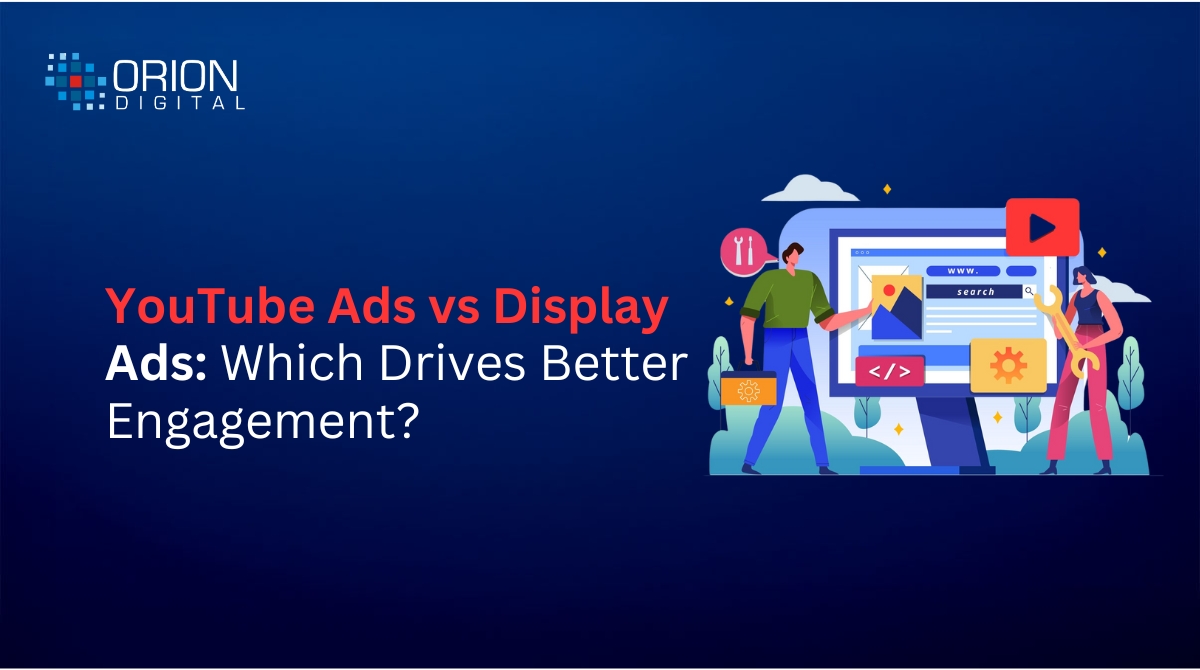
YouTube Ads vs. Display Ads: Which Drives Better Engagement?
- Naveen N
- March 28, 2025
- Digital Marketing
- 0 Comments
Selecting the right advertising tactic can make or break a campaign in today’s fast-paced digital marketing environment. Two of the most popular options are Display Ads and YouTube Ads. But which one encourages more engagement? That is a question many brands wonder, and the answer isn’t necessarily clear-cut.
At Orion Digital, we recognize that every brand is different, and so is every ad campaign. In this blog, we’ll explore the major differences between YouTube Ads and Display Ads, how they stack up against each other in terms of driving engagement, and help you better understand which may be the best option for your company.
What Are YouTube Ads?
YouTube Ads are video commercials that are played before, during, or after YouTube videos. They are available in various formats, providing advertisers with choices depending on how they would like to engage their audience:
- TrueView Ads: These are the 5-second skippable ads, and only when people watch these 30 seconds of advertisement or interact with it do advertisers get paid.
- Non-Skippable Ads: As the name indicates, these cannot be skipped and typically last between 15 and 20 seconds.
- Bumper Ads: Brief, snappy 6-second ads ideal for quick brand communication.
- Sponsored Cards: Small, clickable cards within a video that push related products.
What Are Display Ads?
Display Ads are graphic-based ads which appear on all websites and mobile apps in the Google Display Network. They typically appear as sidebars or banners, and are less invasive than video ads, displayed while users engage with content. Display Ads might feature static photos, gifs, or interactive ones that grab the attention.
These advertisements are effective in targeting consumers when they’re surfing online in a relaxed manner but lack the engaging experience of video ads.
Engagement: YouTube Ads vs. Display Ads
When we mention engagement, we mean the way the user engages with advertisements—whether they click, comment, share, or watch a video. So, let’s get down to it:
- The Power of Visuals: Video vs. Static
YouTube Ads: Video ads inherently draw in more attention. A good YouTube Ad can evoke emotions, narrate a story, and establish a more profound connection with the viewer. YouTube Ads are engaging, interactive, and enable brands to communicate their message in a more creative way.
Consider Nike’s “Dream Crazy” campaign, for instance. Starring Colin Kaepernick, this YouTube Ad didn’t merely depict a product—it initiated a debate. It was emotional, philosophical, and incredibly engaging, attracting millions of shares and social media discussions among the viewers.
Display Ads, by contrast, are based on static images that cannot do as much to engage the viewer. Even a cleverly designed and effective ad cannot draw in the audience as much as a video would. But display ads do their job effectively in targeting users with a more overt, less intrusive approach.
- User Intent: Active vs. Passive Engagement
YouTube Ads: When individuals are watching YouTube videos, they are generally in a more passive state. They’re watching content but not actively searching for a product. That does not make them unreachable. A well-targeted YouTube Ad—particularly if it’s in sync with the content that the user is currently viewing—can provide a chance for engagement.
For instance, a travel agency may target users who are viewing vacation planning videos with a promotion so that it becomes relevant and timely.
Display Ads: With Display Ads, users tend to be actively surfing the web for a reason. They’re actively reading a piece of content, shopping, or looking at other content. Display Ads are less intrusive, and they can be used as a subtle reminder or a short call-to-action while users are deciding what they want to do next.
For example, a technology brand might display an ad for a laptop discount when a person is reading a computer review.
- Targeting Capabilities: Precision is Key
YouTube Ads: One of the biggest advantages for YouTube is its targeting. You can target audiences by interest, demographics, and even behaviors. If you want to reach an audience that watches a particular kind of content or searches for a particular product, you can do it with YouTube and find exactly who you’re searching for.
For instance, a sports brand may aim at individuals watching exercise videos such that they notice ads related to exercise equipment or fitness plans.
Display Ads: Display Ads also provide strong targeting features such as interests and demographics. Remarketing is particularly powerful here—if someone has been on your site but didn’t check out, you can show them a display ad to get them back. But although targeting is accurate, display ads tend to be slightly less customized and interactive than YouTube’s dynamic video content.
Engagement Metrics:
When we examine the actual engagement levels, YouTube Ads generally surpass Display Ads in some major areas:
- Video Views: YouTube’s huge audience—more than 2 billion logged-in users every month—gives your video ad a higher opportunity to be viewed. Indeed, TrueView Ads have 15% more engagement than Display Ads, as identified by Google.
- Social Interactions: YouTube Ads also create more social interactions. Users are more likely to like, comment, and share an engaging video ad than they are to do the same for a static display banner.
- Click-Through Rates (CTR): Display Ads generally have lower CTRs. People tend to ignore static banners, particularly if they’re not visually engaging. Still, display ads are helpful in creating brand awareness and making your brand top-of-mind.
When to Choose YouTube Ads vs. Display Ads
Use YouTube Ads When:
- You want to create a strong emotional connection with your audience through storytelling.
- You’re targeting users who are actively consuming content that aligns with your brand’s message.
- You want higher engagement in terms of views, comments, and social shares.
- You have the resources to produce high-quality video content that will resonate with your audience.
Use Display Ads When:
- You want to maintain visibility across the web and increase brand awareness.
- You’re targeting users who have previously interacted with your brand (remarketing).
- You’re looking for quick, visually impactful messages that capture attention in a non-intrusive way.
- You don’t have the resources or time to produce video content but still want to reach your audience.
Conclusion
When it comes to driving engagement, YouTube Ads usually have the edge. They permit more dynamic, emotional, and interactive experiences that result in better engagement rates. Display Ads do have their place, though, particularly for brand awareness, remarketing, and targeting users in various stages of the customer journey.
At Orion Digital, we think that we should build tailored marketing solutions that meet your objectives. Whether it is taking advantage of the engaging nature of video on YouTube or the targeted reach of display ads, we can assist you in maximizing your digital marketing initiatives.
Have you used YouTube Ads or Display Ads?


